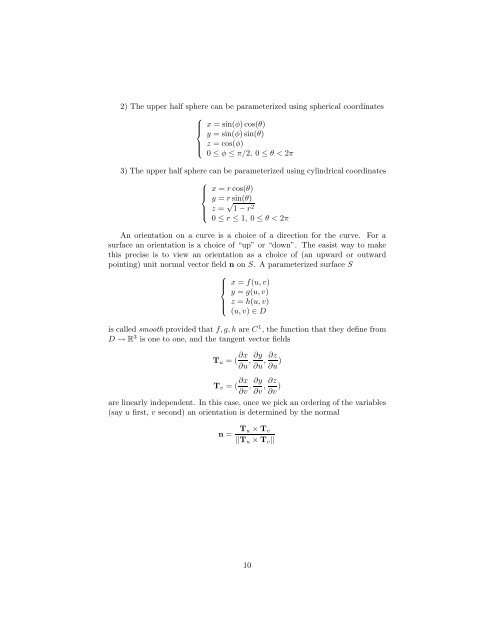Introduction to differential forms
Introduction to differential forms
Introduction to differential forms
Create successful ePaper yourself
Turn your PDF publications into a flip-book with our unique Google optimized e-Paper software.
2) The upper half sphere can be parameterized using spherical coordinates<br />
⎧<br />
x = sin(φ) cos(θ)<br />
⎪⎨<br />
y = sin(φ) sin(θ)<br />
z = cos(φ)<br />
⎪⎩<br />
0 ≤ φ ≤ π/2, 0 ≤ θ < 2π<br />
3) The upper half sphere can be parameterized using cylindrical coordinates<br />
⎧<br />
x = r cos(θ)<br />
⎪⎨<br />
y = r sin(θ)<br />
z = √ 1 − r ⎪⎩<br />
2<br />
0 ≤ r ≤ 1, 0 ≤ θ < 2π<br />
An orientation on a curve is a choice of a direction for the curve. For a<br />
surface an orientation is a choice of “up” or “down”. The easist way <strong>to</strong> make<br />
this precise is <strong>to</strong> view an orientation as a choice of (an upward or outward<br />
pointing) unit normal vec<strong>to</strong>r field n on S. A parameterized surface S<br />
⎧<br />
x = f(u, v)<br />
⎪⎨<br />
y = g(u, v)<br />
z = h(u, v)<br />
⎪⎩<br />
(u, v) ∈ D<br />
is called smooth provided that f, g, h are C 1 , the function that they define from<br />
D → R 3 is one <strong>to</strong> one, and the tangent vec<strong>to</strong>r fields<br />
T u = ( ∂x<br />
∂u , ∂y<br />
∂u , ∂z<br />
∂u )<br />
T v = ( ∂x<br />
∂v , ∂y<br />
∂v , ∂z<br />
∂v )<br />
are linearly independent. In this case, once we pick an ordering of the variables<br />
(say u first, v second) an orientation is determined by the normal<br />
n =<br />
T u × T v<br />
||T u × T v ||<br />
10








